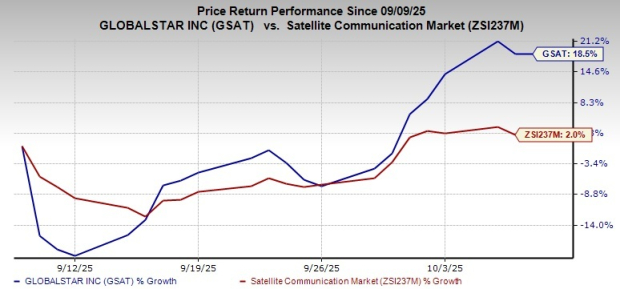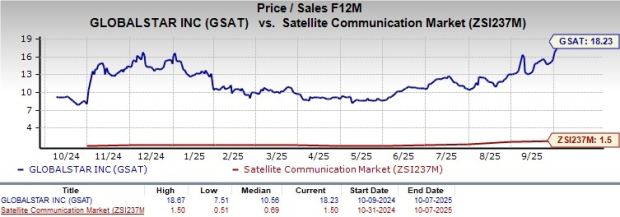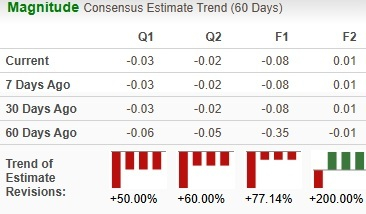|
|
|

|
|||||

|
|
Globalstar GSAT is extending its footprint in the rapidly growing Internet of Things (IoT) connectivity market through a new strategic collaboration with Conekt.ai, a connectivity management platform provider. As per the partnership, GSAT’s Band 53 spectrum and XCOM RAN private network technology solutions will be integrated with Conekt.ai’s orchestration platform, creating a unified solution for multi-network connectivity.
Post integration, Conekt.ai will be able to deliver turnkey connectivity solutions for IoT deployments, private networks and hybrid architectures to enterprise clients. The integration allows enterprise customers to manage and scale IoT applications through Conekt.ai’s single-pane-of-glass orchestration system — combining licensed, interference-free Band 53 spectrum with advanced XCOM RAN capabilities and satellite, and public networks for consistent, high-throughput and secure connectivity. This integration will aid customers (both GSAT & Conekt.ai) across key verticals to easily deploy advanced IoT applications across private and public networks.
GSAT highlighted that this collaboration extends its go-to-market capabilities. By integrating Band 53 spectrum and XCOM RAN solutions with Conekt.ai's device orchestration platform, it gains access to the customer base in IoT and enterprise markets.
Globalstar’s second-quarter 2025 results reflected growing momentum across its wholesale capacity services and commercial IoT initiatives. Commercial IoT is witnessing an increase in the average number of subscribers, driven by robust growth in gross activations in the trailing 12 months. The company’s terrestrial spectrum consists of Band 53 and its 5G variant, n53 and XCOM RAN. On the last earnings call, management highlighted that owning proprietary spectrum is the key differentiator in the satellite communications space, as it provides a long-term competitive advantage.
The company expects momentum to continue with innovations such as the RM200 two-way module and XCOM RAN, which could further drive the top line. The RM200 two-way module is witnessing growing traction across verticals such as oil & gas, defense and MVNOs and has been tested by more than 50 partners. With XCOM RAN, GSAT is eyeing entry into terrestrial wireless sector, significantly broadening its total addressable market.
The satellite and communication industry is fiercely competitive, characterized by swift technological advancements and the rising number of new entrants alongside the incumbents. This could impact GSAT’s revenue trajectory if execution is patchy. Players like Iridium Communications IRDM and Viasat VSAT are eyeing significant expansion of their addressable markets amid the increasing demand for global connectivity.
Iridium continues to deliver growth across key segments like commercial IoT, voice and data, and the government segment. The company’s commercial service segment continues to be the backbone of its business, accounting for 59% of total revenues in the second quarter. The metric rose 2% to $128.8 million, driven by strong IoT performance. Iridium expects to generate about $1 billion in service revenues by 2030.
To achieve this long-term goal, management is focused on developing several services, including Direct-to-Device (Iridium NTN Direct), IoT (Iridium Certus IoT products) and satellite-based personal communication devices in addition to the Iridium Satellite Time and Location service. Iridium’s 25-year relationship with the U.S. Department of Defense is a significant moat.
Viasat is a global communications company that serves its high-bandwidth, high-performance communications solutions to the public as well as the military, enterprise and government sectors. The acquisition of Inmarsat added a fleet of geostationary satellites. The Inmarsat buyout has brought a greater diversity of on-orbit technologies by expanding Viasat’s Ka-band fleet to a total of 13 Ka-band satellites. Inmarsat’s well-established business significantly enhances Viasat’s global distribution. Last month, Viasat announced that the ViaSat-3 Flight 2 (F2) satellite is scheduled to launch in the second half of October 2025. ViaSat-3 Flight 2 (F2) satellite deployment will double VSAT’s bandwidth capacity.
GSAT stock has gained 18.5% in the past month compared with the Zacks Satellite and Communication industry's 2% rise.

Globalstar stock is trading at a substantial premium, with a forward 12-month price/sales of 18.23X compared with the industry’s 1.5X.

GSAT’s estimates are on an upward trajectory at present. The consensus mark for 2025 earnings has been revised up 77.1% to a loss of 8 cents per share over the past 60 days and the same for 2026 has moved north 200% to 1 cent.

At present, GSAT has a Zacks Rank #3 (Hold). You can see the complete list of today’s Zacks #1 Rank (Strong Buy) stocks here.
Want the latest recommendations from Zacks Investment Research? Today, you can download 7 Best Stocks for the Next 30 Days. Click to get this free report
This article originally published on Zacks Investment Research (zacks.com).
| 1 hour | |
| Dec-09 | |
| Dec-08 |
Musk Walks Back SpaceX Funding Reports. Is 2026 IPO In Play?
VSAT GSAT IRDM
Investor's Business Daily
|
| Dec-07 | |
| Dec-05 | |
| Dec-05 | |
| Dec-04 | |
| Dec-04 | |
| Dec-04 | |
| Dec-04 | |
| Dec-03 | |
| Dec-02 | |
| Dec-02 | |
| Dec-01 | |
| Nov-26 |
Join thousands of traders who make more informed decisions with our premium features. Real-time quotes, advanced visualizations, backtesting, and much more.
Learn more about FINVIZ*Elite